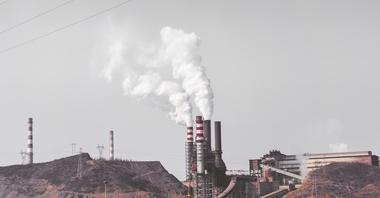
It's Not Just You: There Are a Lot of Heat Waves
As the planet gets hotter, heat waves will strike more frequently —and become more intense.
This year has already broken records – and not the kind to celebrate. From India to Brazil, heat waves are intensifying the impacts of droughts and wildfires, shaking up the global food system, and threatening human lives.
It’s not just you. Things are heating up.
As the climate crisis worsens, we will continue to see the uptick in heat waves that has dominated international news so far this summer – and its deadly consequences.
Heat Waves and Climate
Are heat waves and the climate crisis connected?
In short, yes.
Every day, the sun sends a tremendous amount of energy down to the Earth. Some of this energy is absorbed by the surface and some is reflected back into the atmosphere as heat. Greenhouse gases like carbon and methane can trap this heat energy, a phenomenon known as "the greenhouse effect."
We need greenhouse gases to survive - without them trapping this heat, the Earth would be too cold to sustain life. Where we get into trouble - and here comes the climate connection - is from producing and burning fossil fuels, which releases billions of tons of these gases into the atmosphere every year, trapping more heat than delicate natural systems can handle.
In 2021, the average levels of carbon dioxide in the atmosphere reached the highest levels in recorded history. And this year is no different. We just made history again with a new record for carbon dioxide levels.
What does all of this extra trapped heat do? You guessed it: it makes the planet hotter (and that's just for starters). Across the world, this extra heat is raising average temperatures. In June, Cottbus, just southeast of Berlin, hit an all-time high of 39.2 °C and in April, northwest and central India suffered through the highest average maximum temperatures since 1900.
It's not just average temperatures going up, up, up. Thanks to rising CO2 levels, when heat waves do strike, they're hotter and more dangerous than ever before. Plus, they're also occurring more frequently in major cities across the US. In the 1960s, there were an average of two heat waves a year. In the 2010s, this number increased to six.
This same pattern is repeating worldwide, on a global scale. Researchers found that climate change made the deadly heat waves in India and Pakistan earlier this year a staggering 30 times more likely. The study also predicted that if temperatures continue to move toward 2 ºC above pre-industrial levels, heat waves would be two to 20 times more likely than in 2022 – and 0.5-1.5 ºC hotter.
This Year’s Hottest on Record
Heat waves do more than make us sweat. They also can have wide-ranging - and destructive - consequences for all kinds of critical sectors, including our energy, food, transportation, and healthcare systems.
This spring, India had its hottest March on record, devastating farms and the nation's wheat yield. Before the heat wave arrived, the government planned to step in to provide food relief and alleviate the toll that the Russia-Ukraine crisis is having on the global food system. Instead, India had to ban wheat exports to ensure that its own people had enough to eat.
In June, Japan suffered its worst heat wave since records began in 1875. Temperatures in Tokyo exceeded 35 ºC for five straight days, and in Isesaki, near the capital, temperatures reached 50.2 ºC (104.36°F), setting a record for the hottest day ever seen in June in Japan. A record 15,657 people also went to the hospital due to extreme heat, over half of whom were older adults.
Officials were also concerned about Japan’s energy grid due to an increase in demand for electricity and the country’s vulnerability to blackouts. Heat waves are known to have significant effects on numerous aspects of our energy system, including production, transmission, and demand. Power plants can become less efficient, and demand goes up as people use more energy to stay cool and safe during heat waves. High temperatures can also make it harder for transmission lines to carry power, leading to potential rolling blackouts.
These are just a few of the ways heat waves have affected people and the planet this year. But what other effects do rising temperatures have?
More Heat = More Injustice
Heat waves are also an environmental justice issue. Extreme heat hits communities of color and low-income neighborhoods the hardest.
One study found that in cities, low-income neighborhoods of color can be up to 13°F hotter than whiter, wealthier neighborhoods. Lower-income families can also have more challenges staying cool, with higher energy bills if their homes are not especially energy efficient.
Whiter and wealthier neighborhoods also have more cooling infrastructure, such as trees and parks, which can help mitigate the impacts of the urban heat island effect. Inequities in who experiences extreme heat – and who has cooling infrastructure and greenspace near them – have also been tied to racist policies such as redlining.
Heat waves are also particularly dangerous for our most vulnerable populations, including children, older adults, people with chronic health conditions, and those who work outdoor jobs. Communities of color also experience higher rates of chronic medical conditions, which can be worsened by extreme heat. Each year, extreme heat causes more American deaths than any other kind of extreme weather.
Heat and Water: Too Little – and Too Much
As the planet heats up, evaporation increases, which often means less water and drier conditions. Heat waves are known to exacerbate the impacts of droughts and wildfires. From 2019 to 2020, bushfires raged across Australia during an “unprecedented” heat wave, burning over 17 million hectares of land.
Besides drying everything out, heat waves also put pressure on marine life. We might think of a lake, river, or ocean as a way to beat the heat, but these ecosystems are fragile. Oceans are absorbing more than 90% of the increased atmospheric heat associated with greenhouse gas emissions, and marine life often struggles to adapt to these warming waters.
During last summer’s heat wave in the US Pacific Northwest, for example, more than 1 billion sea creatures are estimated to have died as a result of increasing temperatures. This also extends to freshwater ecosystems. Last summer, the California Department of Fish and Wildlife warned that heat waves could cause a “near-complete loss” of young salmon in the Sacramento River. Beyond just fisheries, warmer temperatures also contribute to a decrease in potable water and an increase in harmful algal blooms,. which can produce harmful toxins, cause dead zones in the water, make water treatment more expensive, and negatively impact industries that depend on clean water.
Extreme heat can also have the opposite effect: too much water. Warmer temperatures also mean less sea ice. These melting glaciers and ice sheets have sped up sea-level rise, which puts coastal communities in peril. Water also expands as it warms, which means that as our oceans heat up, the water occupies more space. Eight of the world’s 10 largest cities are located near a coast, and Cornell University researchers estimate that by the year 2100, 2 billion people – equivalent to one-fifth of the world's population – could be forced to leave their homes due to rising seas.
Heat and Extreme Weather
Rising temperatures can also increase the frequency and intensity of extreme weather events like hurricanes, wildfires, flooding, and drought.
For example, the extra heat energy in warmer ocean temperatures acts as fuel for hurricanes, making strong storms even more powerful. Specifically, how strong a storm becomes – and how fast it intensifies – is impacted by how warm the waters are along its path. To put it simply, warming temperatures are making storms stronger and more damaging.
And because warmer oceans can lead to storms to rapidly intensify, a weaker tropical storm can quickly become a major hurricane if it comes into contact with the right waters. This can also cause people – even those who live in hurricane-prone areas – to be under-prepared for the strength of the hurricane that actually hits their communities, which can lead to even greater damage, injuries, and even loss of life.
This doesn’t just mean higher wind speeds – it also means a lot of water.
Hurricanes are also major rainfall events that can unleash dangerous storm surges on coastal communities and beyond. As hurricanes get stronger, rains are becoming heavier and storm surges – when ocean water pushes into the coast – are getting higher and moving farther inland.
What Happens Now?
The good news is that we already have all of the tools that we need to address these rising temperatures and fight the climate crisis.
A community-led, just transition to clean energy and away from fossil fuels is one way we can combat the climate crisis and lower our carbon emissions. This transition also incorporates the creation of millions of green jobs and healthier, more equitable communities.
This can feel far away, especially after the Supreme Court's recent decision in “West Virginia vs. EPA” severely limited the agency's ability to regulate and reduce power plant emissions. But our fight isn’t over. Senate leadership may soon be considering a climate bill which has a host of clean energy tax credits and other climate solutions.
This summer – before the mid-term elections – is likely the last window that we will have to pass a climate bill. And we need your help. We know this has been a long fight. We’re tired, too. But if we want to be able to curb the worst effects of the climate crisis, we have to take action before it’s too late.




